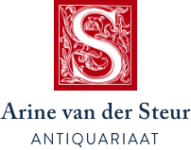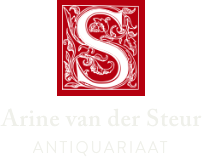Giovanni Battista Piranesi (1720-1778)
[Antique print, etching, Piranesi] Uno delli due Dadi fatti a guisa di Piedestallo in tutto simili, i quali esistono nel Museo Capitolino. (Piramide van Cestius), published 1756-1784, 1 p.
Plate XLII from the III out of four volumes collection Le Antichità Romane collecting plates by Giovanni Battista Piranesi, firstly published by Angelo Rotili in Rome between 1756 and 1757. The second edition appeared in 1784. Original wide margins, no traces of binding or folding. Two plates, one with illustration, the other with explanatory text.
Titled below: ‘Uno delli due Dadi fatti a guisa di Piedestallo in tutto simili, i quali esistono nel Museo Capitolino .’
Signed on the bottom right: ‘Piranesi Archit. dis. ed inc. ‘.
“The plate reproduces various archaeological finds found near the Pyramid of Cestius, at the time of the excavations commissioned by Pope Alexander VII in 1667. In particular, one of the two plinths bearing the testamentary inscription, preserved – today as then – at the Capitoline Museums (CIL, VI), on which the bronze statues dedicated to Caio Cestio were placed. Fragments of the same statues, some drums, capitals and, in the background, the two columns that were erected on the sides of the tomb during the excavation are here visible.
De Piramide van Cestius is een antieke piramide in Rome. De piramide staat aan de Via Ostiensis vlak bij de Porta San Paolo, aan de rand van Rome. De piramide werd in de Middeleeuwen “Meta Remi” genoemd. Ondanks de grote inscriptie met de naam Gaius Cestius dachten de Romeinen destijds dat dit de graftombe was van Remus, de tweelingbroer van de stichter van de stad Rome, Romulus. Waarschijnlijk was de piramide destijds zo overwoekerd met planten dat de inscriptie onleesbaar was.
SKU: PR120826
Etching with some interventions in burin on hand laid paper, with broad margins; plate mark: 559 x 391 mm; total 800 x 574 mm; somewhat frayed end margins, a damp stain on the bottom margin, otherwise in great condition. Visible watermark.
€ 254,10(€ 210,00


![[Antique print, etching, Piranesi] Uno delli due Dadi fatti a guisa di Piedestallo in tutto simili, i quali esistono nel Museo Capitolino. (Piramide van Cestius), published 1756-1784, 1 p [Antique print, etching, Piranesi] Uno delli due Dadi fatti a guisa di Piedestallo in tutto simili, i quali esistono nel Museo Capitolino. (Piramide van Cestius), published 1756-1784, 1 p.](https://arinevandersteur.nl/wp-content/uploads/WhatsApp-Image-2022-08-16-at-2.45.58-PM.jpeg)
![[Antique print, etching/ets, Rome] AMPHITHEATRI ... Views of Rome [Set title] (Amphitheatrum Castrense), published 1705, 1 p.](https://arinevandersteur.nl/wp-content/uploads/WhatsApp-Image-2022-08-25-at-3.26.47-PM1-356x356.jpeg)
![[Antique print, etching/ets, Rome] AMPHITHEATRI ... Views of Rome [Set title] (Amphitheatrum Castrense), published 1705, 1 p.](https://arinevandersteur.nl/wp-content/uploads/WhatsApp-Image-2022-11-14-at-15.54.30-356x356.jpeg)
![[Antique print, etching/ets, Rome] CASTELLUM S. ANGELI... Views of Rome [Set title] (Engelenburcht), published 1705, 1 p.](https://arinevandersteur.nl/wp-content/uploads/WhatsApp-Image-2022-08-25-at-3.09.49-PM1-356x356.jpeg)
![[Antique print, etching/ets, Rome] MAUSOLEUM... Views of Rome [Set title] (Graftombe van Augustus), published 1705, 1 p.](https://arinevandersteur.nl/wp-content/uploads/WhatsApp-Image-2022-08-25-at-3.11.41-PM-356x356.jpeg)
![[Antique print, etching, Rome] VOORNAAMSTE GEBOUWEN Vande Tegenwoordige STADT ROMEN (view of the Vatican Palaces), published ca. 1681.](https://arinevandersteur.nl/wp-content/uploads/WhatsApp-Image-2022-08-25-at-11.34.57-AM-356x356.jpeg)
![[Antique print, etching, Rome] RVINARVM TEMPLI PACIS / PROSPECTVS I [The Basilica of Constantine], published 1550-1551, 1 p.](https://arinevandersteur.nl/wp-content/uploads/59843_1-scaled-1-356x356.jpg)
![[Antique print, etching, Piranesi] Pianta della Piramide di Cajo Cestio presso la Porta di S. Paolo (plan of pyramid of Cestius)., published 1756-1784, 1 p.](https://arinevandersteur.nl/wp-content/uploads/WhatsApp-Image-2022-08-16-at-2.45.25-PM1-100x100.jpeg)
![[Antique print, etching, Piranesi] Modo, col quale furono alzate le grandi Pietre....(lifting instruments tomb of Caecilia Metella), published 1756-1784, 1 p.](https://arinevandersteur.nl/wp-content/uploads/WhatsApp-Image-2022-08-16-at-2.33.36-PM-1-100x100.jpeg)